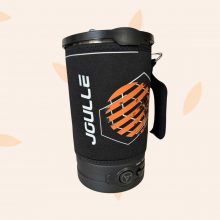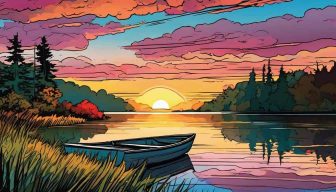
I first experienced Northern California backpacking on a road trip traveling along the Pacific Coast Highway.
The coastal and mountain wilderness in this part of the state is so beautiful that it stuns you, and there are a number of moments when the surrounding nature feels more like a mystical paradise.
Whether you’re a novice backpacker or an experienced hiker, there are a tons of natural gems along the Best Northern California Backpacking routes.
This article will provide you with some of the best destinations for your next backpacking trip – from Yosemite National Park to the Lost Coast.
Best Northern California Wilderness Backpacking

Stanislaus National Forest
Stanislaus National Forest is a protected area in Northern California that covers more than 898 thousand acres of land. It’s located in the Sierra Nevada mountain range and is a treasure trove of mountain peaks that appear to touch the clouds, deep canyons, diverse eco-systems, and lush forests.
- Pinecrest Lake Loop: 3.8 miles / 6.1 kilometers (Easy)
- Highland Lakes Loop: 7.8 miles / 12.6 kilometers (Moderate)
- Crabtree Trail to Bear Lake: 8.3 miles / 13.4 kilometers (Moderate to difficult)
- Kennedy Meadows to Relief Reservoir Trail: 14.6 miles / 23.5 kilometers (Difficult)

Carson-Iceberg Wilderness
The Carson-Iceberg Wilderness is comprised of more than 200 thousand acres of land that reaches across both Alpine & Tuolumne Counties, located within the larger Stanislaus National Forest. You can reach the area from Highway 108 and Highway 4.
The region is known around the world because the Pacific Crest Trail (PCT) also runs through for 273 miles, and the wilderness area has a lot of topographical diversity, including mountains, valleys and waterfalls.
- Unique Features: Elevations from 4,800 feet (1,500 m) to 11,462 feet (3,494 m) along the Sierra Mountains from Ebbetts Pass to Sonora Pass in the south
- Trails:
- Sword Lake via Pack Trail: 2.5-mile (Easy)
- Wolf Creek Lake Trail: 5-miles (Moderate)
- Pacific Crest Trail: 26+ miles (Difficult)
- Asa Lake via Pacific Crest Trail: 30.2-miles (Difficult)

Devil’s Punchbowl in Klamath National Forest
Located in Klamath National Forest, the trail to the Devil’s Punchbowl stretches across peaks and valleys, with an array of diverse conifer species to admire along the way, including evergreen pines, firs and sequoias, and wildflower blooms that change seasonally.
- Unique Features: Smith River National Recreation Area, Devil’s Punchbowl unique geological formation
- Trails:
- Devil’s Punchbowl Loop Trail: 1-mile loop down into the center of the rocks.
- Doe Flat Trail to Devil’s Punchbowl: 9-mile Leads to the Siskiyou Wilderness

Clear Creek in Mount Shasta Wilderness
The Clear Creek trail to Mount Shasta is a gateway trail that provides access to three routes that ascend up to the more than 14 thousand feet summit of Mount Shasta — the highest peak in Northern California. Nicknamed “nature’s skyscraper,” Mount Shasta is challenging terrain with waterfalls, canyons and rocky basins.
- Unique Features: Mud Creek Canyon, Mount Shasta
- Trails:
- Clear Creek Trail: 11.4-miles with elevation of 8,500 feet (Difficult)

Ventana Wilderness
The Ventana Wilderness, located in the Los Padres National Forest, is the starting point for a number of trails that extend along the 5,000-foot-high Chews Ridge, all the way to Big Sur Station, with elevation that ranges from sea level to 8 thousand feet. Trails in this area encompasses waterfalls, lakes and hot springs.
- Unique Features: Starts at Big Sur Station near sea level and leads to China Camp on Tassajara Road at 5,000 feet (1,500 m)
- Trails:
- Arroyo Seco Trail: 4.66-miles (Easy-moderate)
- Pine Ridge Trail to Post Creek Trail: 3.2-miles (Easy)
- Sykes Hot Springs via Pine Ridge Trail: 19.7-miles (Difficult)
- Pine Ridge Trail: 19.5-miles with steep elevations (Difficult)

King Peak in King Range National Conservation Area
The King Range National Conservation Area is a 42,585-acre reserver that is known for world-class mountain biking, coastal wilderness, and the King Peak – a mountain summit that stands tall more than 4 thousand feet above sea level, making it one of the highest shoreline peaks in the US.
- Unique Features: King Peak, California’s Lost Coast
- Trails:
- Black Sands Beach via Lost Coast Trail: 25.5-mile (Difficult)
- Mattole Beach via Lost Coast Trail: 5.4-mile (Moderate)

Highway 5 Section P to Etna Summit in Klamath National Forest
The Highway 5 Section P to Etna Summit hike takes multiple days to finish, and provides splendid sights within the Klamath National Forest and serves as a gateway to the Russian Wilderness beyond it.
This challenging backpacking trail starts near Castella, California and climbs up towards Taylor Lake – about 1.5 miles away from Etna Summit, with Mount Shasta overlooking.
- Unique Features: Marble Mountain, Russian Wilderness, Pacific Crest Trail (PCT), Upper Ruffey Lake
- Trails:
- PCT: CA Section P – Highway 5 to Etna Summit: 96.7 miles (Difficult)

Canyon Creek Lakes in Trinity Alps Wilderness
With an elevation gain of 3,051 feet, the Canyon Creek Lakes Trail takes you to the 7th highest peak in California! Depending on the time of year, as you hike up this ascent you may find fields of wild flowers native to the area, including tiger lillies and Indian paintbrush.
- Unique Features: Trail ends at the 7th highest peak in California
- Trails:
- Canyon Creek Lakes Trail: 18.6-miles with 3,051 feet elevation gain (Difficult)
Best Backpacking Trails in Yosemite

Yosemite National Park, covering almost 1,200 square miles, lies mostly within the basins of the Merced and Tuolumne rivers. The park is known for its waterfalls, valleys, expansive wilderness areas, centuries-old gigantic sequoias, and huge meadows. Geographically, it’s almost equidistant from San Francisco (140 miles / 225 km) and Sacramento (100 miles / 160 km).
The Sequoia and Kings Canyon area of Yosemite is home to ancient sequoia trees, which are some of the largest and oldest on Earth. In fact, the world’s largest tree is here, named General Sherman.

Half Dome Trail
The Half Dome Trail rises nearly 5 thousand feet above Yosemite Valley and more than 8 thousand feet above sea level. This trail is not for beginners or the faint of heart. It requires mountaineering, climbing expertise, and the proper equipment.
In spite of the difficulty, Half Dome offers respite and relaxation in the Washington Column Falls waterfall and views of the Sierra Nevada mountain range. For those who reach the final summit of the Half Dome peak, there’s an adrenalin-filled thrill with a 60m cables section to repel back down to the base!
- Unique features: Vistas of Vernal and Nevada Waterfalls, Liberty Cap, Half Dome, and full views of Yosemite Valley and the High Sierra.
- Length: 14-23 miles / 22.5-37 kilometers, depending on the trail (Difficult, requires hiking experience and proper equipment)
Glacier Point Trail
The Glacier Point Trail is a popular loop in Yosemite National Park that sits about 30 miles from the Yosemite Valley, with views of both Half Dome and the High Sierras. The route ascends to an elevation gain of 3,200 feet and offers hikers access to Illilouette Falls.
- Unique features: Views of Yosemite Valley, Half Dome, Yosemite Falls, Sierra mountain peaks, access to Sentinel Dome, Taft Point, Crocker Point, Stanford Point, Dewey Point, and Inspiration Point.
- Length: 9.6-miles / 15.45 kilometers (Moderate to difficult)

Tuolumne Meadows Trail to Yosemite Valley
- Unique features: Incredible mountain views and access to lakes.
- Length: Approximately 27 miles / 43.5 kilometers (Moderate to difficult)
Pohono Trail to Old Inspiration Point
- Unique features: Views of granite rock formations.
- Length: Approximately 8.5 – 13 miles, depending on the route (13.7 – 20 kilometers).
- Difficulty level: Moderate.
Hetch Hetchy Trail to Rancheria Falls
- Unique features: Waterfalls and hidden reservoirs ideal for taking a dip, including Rancheria Falls, Hetch Hetchy Reservoir, this hike also crosses O’Shaughnessy Dam.
- Length: 13 miles /20.9 kilometers (Moderate)
May Lake Trail
- Unique features: Views of Half Dome, May Lake and Yosemite Valley
- Length: 5 miles / 8 kilometers (Moderate to difficult)
Snow Creek Trail
- Unique features: Snow Creek Falls, views of Half Dome
- Length: 12 miles / 19.3 kilometers (Difficult)
May Lake Trail to Mt Hoffman
- Unique features: Alpine lakes surrounded by mountains, views of the 10,000′ Mount Hoffmann
- Length: 6.5 miles / 12.1 kilometers (Moderate)
Mist Trail
- Unique Features: Views of two waterfalls: Vernal Fall and Nevada Fall.
- Length: 3.5 miles / 5.6 kilometers (Moderate to difficult because of steep, slippery sections and numerous stairs)

High Sierra Trail
- Unique Features: Views of the Sierra Nevada Mountains, glacially-carved canyons, subalpine forests, alpine meadows, and high-altitude lakes
- Length: 70-miles (Difficult)
Best Northern California Coastal Backpacking
Backpacking in Big Sur
Take in the striking views from high mountain peaks and wild coastal meadows offered by backpacking trails like Cone Peak Loop and Redwood Falls Loop Trail.
Cone Peak Loop
The Cone Peak Loop culminates at the Cone Peak Mountain, which stands at a 5,155 ft elevation and is about 3 miles from pacific coast, the trip provides amazing views of the ocean. Hikers need to be be prepared for an unkept path, with toppled trees and potential landslides.
- Unique Features: Views of the Pacific Ocean from more than 5,000 feet (1,524 meters) above sea level.
- Length: 5-mile loop / 8.05 kilometers (Difficult because of the steep elevation gain)
Redwood Falls Loop Trail in Plumas National Forest
- Unique Features: Some of the tallest redwood and sequoia trees in the Plumas National Forest.
- Length: Less than 1 mile / 1.6 kliometers (Easy, great for kids)
The Redwood Falls Loop Trail in the Plumas National Forest offers hikers the opportunity to explore untouched, ancient redwoods and giant sequoias, combined with picture-perfect vistas from Sky High Mountain Range.
Point Reyes National Seashore Backpacking
Point Reyes Coast Trail
Point Reyes Coast Campground–next to Drake’s Bay and in the Phillip Burton Wilderness–is perfect for backpackers looking for an experience that involves beach camping with a chance to witness the local marine wildlife.
- Unique Features: Tule elk reserve, grey whale watching, spring wildflowers, coastal views
- Trails:
- Bear Valley Trail: 8.2 miles with a 700+ feet elevation (Moderate)
- Chimney Rock hike: 1.6 miles with less than 300 feet elevation (Easy)
- Limantour Spit: 4.8-mile (Easy – moderate)
- Tomales Point Trail: 9.3 miles, with a 1,100 feet elevation (Moderate)
Bear Valley Trail
Located just 30 miles north of San Francisco and with opportunities for year-round camping and hiking, Bear Valley affords views of NorCal’s diverse landscape; with wildflowers in the springtime; abundant faunas during summer months; brilliant fall foliage in autumn and snow in winter.
- Unique Features: Forests, meadows, and coastal views, passes through Point Reyes National Seashore.
- Trails:
- Bear Valley Trail to Glen Camp Loop: 8-mile round trip (Moderate)
- Sky Trail and Bear Valley Loop: 12.2-mile round trip, with 1,850 feet elevation (Difficult)
- Bear Valley to Coast Camp Loop: 10-mile (Difficult)
- Bear Valley / Coast Trail Loop: 22-mile with 1,259 feet elevation
Best Northern California Mountain Backpacking
Marble Mountain Wilderness
- Unique features: Cliff Lake, Sky High and Shadow Lakes, Box Camp Mountain and Marble Mountain
- Trails:
- Cliff Lake Via Shackelford Creek Trail: 4.7-mile (Difficult)
- Lover’s Camp to Sky High and Shadow Lakes: 4.5-miles (Difficult)
- Campbell Lake: 7-miles (Moderate)
Related Posts:






